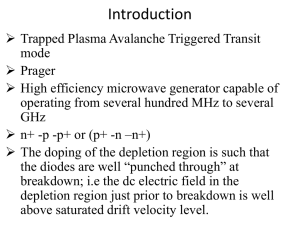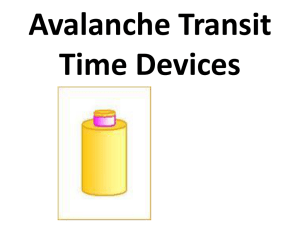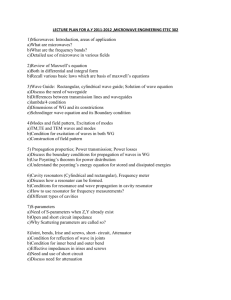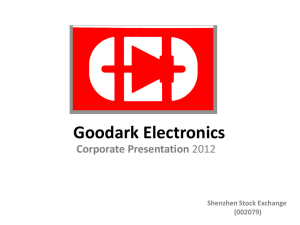RF-UNIT-IV
advertisement
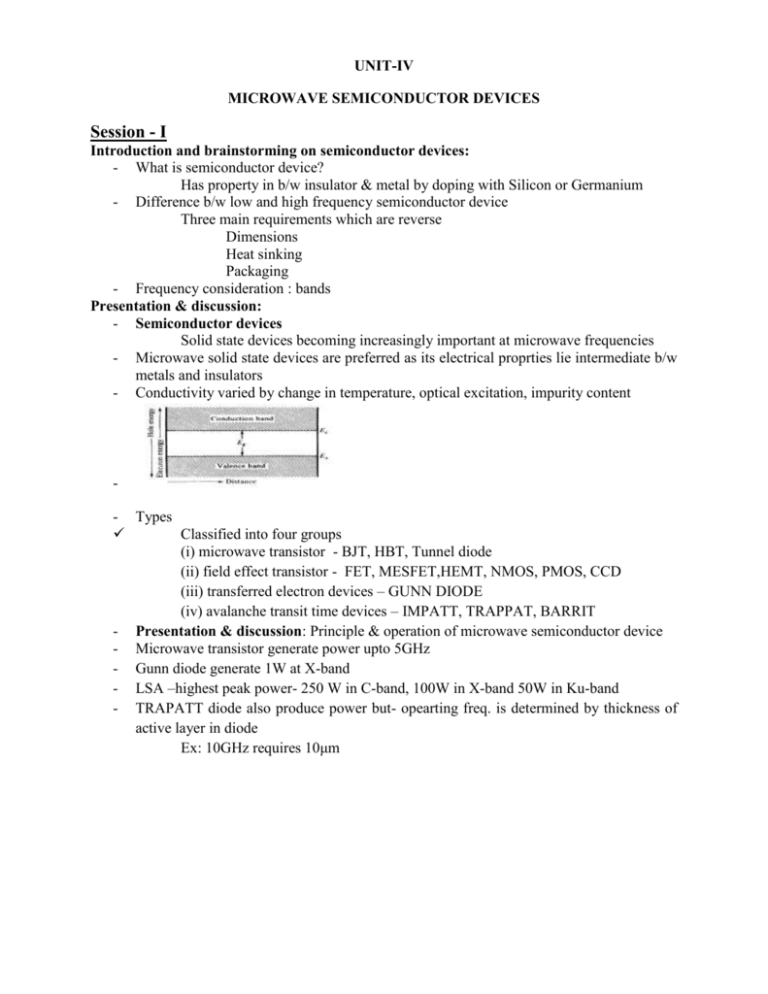
UNIT-IV MICROWAVE SEMICONDUCTOR DEVICES Session - I Introduction and brainstorming on semiconductor devices: - What is semiconductor device? Has property in b/w insulator & metal by doping with Silicon or Germanium - Difference b/w low and high frequency semiconductor device Three main requirements which are reverse Dimensions Heat sinking Packaging - Frequency consideration : bands Presentation & discussion: - Semiconductor devices Solid state devices becoming increasingly important at microwave frequencies - Microwave solid state devices are preferred as its electrical proprties lie intermediate b/w metals and insulators - Conductivity varied by change in temperature, optical excitation, impurity content - Types Classified into four groups (i) microwave transistor - BJT, HBT, Tunnel diode (ii) field effect transistor - FET, MESFET,HEMT, NMOS, PMOS, CCD (iii) transferred electron devices – GUNN DIODE (iv) avalanche transit time devices – IMPATT, TRAPPAT, BARRIT - Presentation & discussion: Principle & operation of microwave semiconductor device - Microwave transistor generate power upto 5GHz - Gunn diode generate 1W at X-band - LSA –highest peak power- 250 W in C-band, 100W in X-band 50W in Ku-band - TRAPATT diode also produce power but- opearting freq. is determined by thickness of active layer in diode Ex: 10GHz requires 10μm Conclusion & Summary: recall by key words - HEMT - High electron mobility transistor - TED – Transferred Electron diode - IMPATT - Impact ionization avalanche transit time diode - TRAPATT - trapped plasma avalanche triggered transit time diode - GUNN – TED semiconductor diode Session – II Introduction & discussion: - Bipolar junction transistor – BJT: - Si n-p-n type – 5 GHZ oper. Freq. - At high temp. & high radiation field GaAs used - Three types of configuration: (i) common – base, (ii) common – emitter, (iii) common - collector - Mode of operation: (i) normal mode, (ii) saturation mode, (iii) cut-off mode, (iv) inverse mode - Field effect transistor – FET Presentation & discussion: - Operation of BJT & FET - Three regions of I-V charcteristics: (i) active region- Ic depends on Vc, Ie (ii) saturation- Ic increases sharply (iii) cut-off – non active - High frequency Limitation: - At high frequencies, reactance due to junction capacitance limits the gain. - Capacitance depletion layer width - depends on & bias voltage provides - feedback path Transit time reduced by narrow p & n region Also reduced by reducing depletion layer width but it need higher collector voltage without avalanche breakdown but increases power dissipation, damage the device power frequency limitation of BJT: Four equations - Vg is 0, no drain current Id For small Vd b/w is applied, n-type act as simple resistor, hence current Id increases linearly with Vd If Reverse gate voltage Vg is applied, majority of electrons depleted from the channel & charge region extends Characteristic & application of BJT & FET Conclusion & summary: recall by key words - Negative resistance - Energy band - Forbidden band - Valence and conduction band - Tunneling - Comparison b/w PN diode & tunnel diode Session – III Presentation & Video: - Operation of Tunnel diode - Negative resistance semiconductor p-n junction diode - Negative resistance is created by tunnel effect of electrons in p-n junc. - Both have high impurity concentration of 1019 to 1020 - Useful in amplification, oscillation and binary memory Principle of operation: - Depletion layer barrier at junction is very thin such that particle will tunnel through the barrier even though no kinetic energy - Filled energy state in one side and allowed empty state on other for tunneling - - 0 < V <Vp: - V=Vp: Vp< V <Vv: Vv< V <α : - Characteristic & application of Tunnel diode - www.youtube-tunneldiode.flv Presentation: - Principle of Varactor diode - Operation of Varactor diode Video Presentation: www.youtube.com/watch?v=dTEOVD0eBsM http://www.learnerstv.com/video/Free-video-Lecture-5089-engineering.htm# Presentation: - Principle of Step recovery diode - Operation of Step recovery diode Conclusion & summary: List by key words - Voltage variable junction capacitance - Varactor frequency multiplier - Comparison b/w varactor& step recovery diode Session – IV Introduction: - TED – Transferred Electron Devices - Microwave transistor - Operate with either junction or gates - Elemental semiconductor are Silicon and germanium - Transistor operate with “warm” electrons of thermal energy of 0.026 eV at room temperature - Transferred electron devices - Bulk devices with no junction or gates GaAs, InP, Cd Te Transistor operate with “hot” electrons very much greater then thermal energy Gunn diode Presentation: - Gunn effect - Above some critical voltage of electric field of 2000 to 4000 volts/cm, current in every specimen become a fluctuating function of time - In GaAs, it is in the form of periodic oscillation - Frequency of oscillation is determined mainly by specimen and not by external circuit - Period of oscillation was inversely proportional to specimen length and closely equal to transit time of electron b/w electrodes - Carrier drift velocity is linearly increased from 0 to maximum, When electric field is varied from 0 to threshold value - When electric field is beyond threshold value of 3000 V/cm, for n-type GaAs, the drift velocity is decreased and diode exhibit negative resistance - RWH theory: - Voltage controlled: - Current density can be multi-valued - High field domain separated by two low domain Current controlled: Voltage density can be multi-valued - Splits the samples with high current filament running along the field directly - - Two valley model - Slide Presentation: - Domain formation - Applied voltage across n+ n n+GaAs, crystal exceeds a threshold level - Electrons are transferred from lower energy to upper high energy - Heavier electrons bunch together to form a electric field dipole domain near cathode - Electric field remains below the threshold level across the rest of the crystal as applied voltage remains constant, thus formation of further domains prevented - High field domain travels and reaches the end contact, again a high domain formed - Each domain results in a pulse of current at the output These current fluctuations occurs at microwave frequencies to produce output signal at the low impedance RF circuit with a period equal to the transit-time Modes of operation (i) Gunn oscillation mode (ii) Stable amplification mode (iii) Limited space charge accumulation mode (iv) Bias circuit oscillation mode - - Video Presentation: http://www.youtube.com/watch?v=MmRaRh-oUHY http://www.youtube.com/watch?v=P9Tr4Q6oFig http://www.youtube.com/watch?v=svuJ42v6RPI Conclusion & summary: List by key words: Quiz - Difference b/w TED & BJT - Transferred electron effect - Materials used - Transit time - LSA - High domain - Quenched domain Session –V Introduction: - Avalanche transit time diodes – IMPATT & TRAPATT - It rely on effect of voltage breakdown across a reverse biased PN junction to produce a supply of holes (or) electrons - It depends on 2 mechanism (i) generation of charge carrier (ii) movement of these charge carrier through a drift space within the semiconductor Presentation: - IMPATT – physical structure - principle - operation - Impact ionization avalanche transit time diode - Employs impact ionization and transit time properties to produce negative resistance at microwaves. - Negative resistance arise due to two delays (i) avalanche delay (ii) transit time delay - Avalanche delay is caused by finite build up time of avalanche current - Transit time delay is due to the finite time taken by the carriers to cross the drift region - These two delays add upto 180°, the diode electronic resistance becomes negative and corresponding to that frequency, ionization occurs which results in large multiplication of current (or) avalanche breakdown occurs - By proper thickness, doping level, a desired RF frequency can be generated - Construction: - many forms such as n+ p i p+ (or) p+ n i p+ p+ n p+ abrupt junction p+ i n+ diode - Presentation & Derivation: - Negative resistance - Manufactured from Ge, Si, GaAs, InP - But GaAs provide highest efficiency, highest operating frequency and least noise figure but fabrication is difficult and expensive than Si. - When large reverse bias voltage is applied, some electrons & holes in region of peak field gain enough energy and thus ionize the atoms in the crystal - Thus an impact ionization mechanism creates an electron & hole pair - The electrons and holes thus created are accelerated by the field in the opposite direction and can cause additional impact - Power output - Performance, Advantages, Applications, Equivalent circuits Conclusion & summary: recall by key words: - Avalanche breakdown - Avalanche transit time - Delayed transit time - Doping level - Noise figure - Disadvantage Session –VI Introduction: - TRAPATT - Trapped plasma avalanche triggered transit time diode Presentation: - Principle –physical structure-operation of TRAPATT - High efficiency oscillation of several hundred MHz to several GHz - Dense plasma of electrons and holes are formed and fills in depletion layer and trapped in low field region - Performance: CW power = 1-3W Pulse power = 1-3W Operating voltage = 60-150V Efficiency = 15 -40% Noise figure = >30dB Frequency = 3 – 50GHz Disadvantages: High noise figure Generates strong harmonics due to short duration of current pulse Application: Used in low power Doppler radar Used as local oscillator for radar, microwave beacon landing system, radio altimeter, phased array radar Conclusion & summary: list by key words: - Configurations - Carrier transit time - Plasma formation - Plasma extraction - Comparison b/w IMPATT & TRAPATT Session –VII Introduction: Parametric devices – its use: - Uses nonlinear reactance (or) time varying reactance - Used to produce capacitance or inductive excitation - Varactor diode is most used as parametric amplifier for its low noise amplification - Uses ac voltage rather than dc voltage Presentation& derivation: Principle: - Negative resistance analysis: - Reactance – circuit element that stores and releases electromagnetic energy - capacitance c = Q / V - For nonlinear C(v) = ∂Q / ∂ V - For inductance L(i) = ∂Q / ∂ i - Small signal method: - Signal voltage(Vs) smaller than pumping voltage(Vp) - Total voltage across nonlinear capacitor C(t) is - - - - ii)Large signal method: Signal voltage not small compared to pumping voltage - Capacitance C is proportional to - Manley Rowe power relation: Derived a set of general energy relations regarding power flowing into and out of an ideal nonlinear reactance Presentation & derivation & Video: - Operation – up & down converter – application - Video presentation - http://www.youtube.com/watch?v=zVlWCz9vTL4 - http://www.youtube.com/watch?v=KrEGji7zzSA&feature=related - http://www.youtube.com/watch?feature=endscreen&NR=1&v=yiJPfuKYXWA Conclusion & summary: recall by key words: - Manley Rowe relation - Idler frequency - Signal frequency - Pumping frequency - Degenerate mode - Regenerate mode - Up converter - Down converter Session –VIII Discussion & introduction: - Integrated circuits - Microwave monolithic integrated circuits(MMIC) Presentation: - Microwave monolithic integrated circuit - Materials used– substrate – conductive Presentation: - MMIC -dielectric materials - resistive materials Conclusion & summary: list by key words: Quiz - Substrate material & conductive materials - Dielectric & resistive materials - Properties of materials - Etchability - Solderability Session – IX Discussion & introduction: - Microwave monolithic integrated circuits(MMIC) Video Presentation: - Fabrication techniques – oxidation – deposition – etching – examples - Video presentation - http://www.youtube.com/watch?v=6T8axj-hMxc&feature=fvwrel - http://www.youtube.com/watch?v=gBAKXvsaEiw - http://www.youtube.com/watch?v=Q5paWn7bFg4&feature=related - http://www.youtube.com/watch?v=i8kxymmjdoM&feature=related - http://www.youtube.com/watch?v=aoDgulny31M&feature=related Conclusion & summary: recall by key words - Ion implantation - Diffusion - Lithography - Epitaxial growth - Etching process - Photo resist - Dc sputtering - Vacuum evaporation

